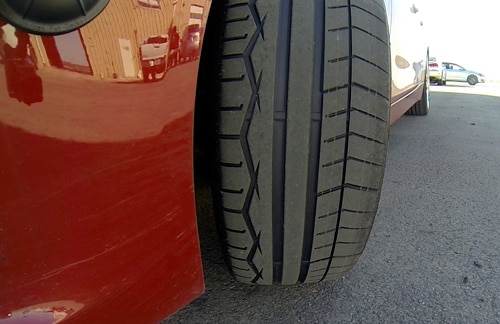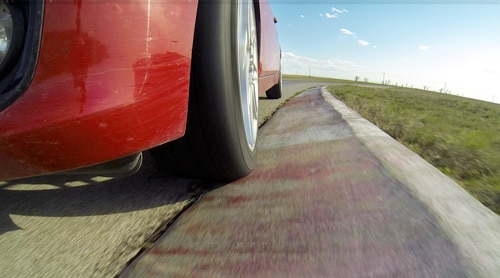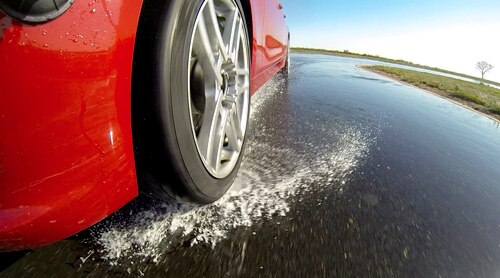March 29, 2014
Vehicles Used
2014 BMW F30 328i Sedan
Race track country clubs that cater to driving enthusiasts, local sports car clubs that rent the track for a weekend
of hot laps for its members, and a growing number of high performance driver education events (HPDE) have opened the
gates to anyone who seeks the thrill of driving at the limit in the relative safety of a racetrack environment. That
means more driving enthusiasts today can turn a wheel on a racetrack than ever before.
This growth in track time for enthusiasts has coincided with the growth of several categories of DOT-legal,
track-focused tires. In today’s tire world there are a variety of tire options for drivers wanting to enjoy their
car at the track, from specialized Racetrack & Autocross Only (but still DOT-legal) R-compound semi-slick tires,
to street-friendly Extreme Performance Summer tires. In the middle are Streetable Track & Competition tires
designed for the track, but engineered to cope with the variety of tasks driving them to and from the track brings
to the equation.
 Continental has recently entered the fray with the ContiForceContact. Developed in Europe with several key tuning
partners like AC Schnitzer and Techart, the ContiForceContact is designed to challenge the dry performance of
established favorites while adding improved wet weather performance.
Continental has recently entered the fray with the ContiForceContact. Developed in Europe with several key tuning
partners like AC Schnitzer and Techart, the ContiForceContact is designed to challenge the dry performance of
established favorites while adding improved wet weather performance.
To find out how well the ContiForceContact delivers on its promise, Continental invited several members of the Tire
Rack team to experience it in a track environment side by side with two benchmarks in the category, the Michelin
Pilot Sport Cup and Toyo Proxes R888. The original Pilot Sport Cup tested here really invented the Streetable Track
& Competition category, and is well known for delivering capable dry track performance mated with a
road-friendly demeanor. The Proxes R888 is actually a Racetrack & Autocross Only competition tire not intended
for use on public roads, but was included in this comparison as it’s one of the more popular options for drivers who
want the elevated performance of a real track tire, but don’t want to use shallow treaded, semi-slick R-compound
track-only tires.
For our test we used a familiar platform to us, a BMW F30 328i sedan riding on full-tread depth 235/40R18 tires.
While the 328i’s torquey little turbo motor may be a little underpowered to significantly challenge drive traction
exiting faster corners, the BMW 3 series has a capable chassis on the track, making it a reasonable compromise to
average the wide variety of cars that see track duty.
Dry Performance
 Dry traction and handling is what Streetable Track & Competition tires are all about, and why track day
enthusiasts use them in the first place. Our test comprised of 5-6 laps by each of several drivers running until
consistent lap times within a few tenths were achieved. The 1.6 mile road course featured moderate elevation
change mixed with predominantly third and fourth gear corners, a second gear S-turn section and peak straightaway
speeds right at 100mph.
Dry traction and handling is what Streetable Track & Competition tires are all about, and why track day
enthusiasts use them in the first place. Our test comprised of 5-6 laps by each of several drivers running until
consistent lap times within a few tenths were achieved. The 1.6 mile road course featured moderate elevation
change mixed with predominantly third and fourth gear corners, a second gear S-turn section and peak straightaway
speeds right at 100mph.
| Tire |
Avg. Lap Time (seconds) |
| Continental ContiForceContact |
90.85 |
| Michelin Pilot Sport Cup |
89.82 |
| Toyo Proxes R888 |
91.32 |
In the first flying lap on the ContiForceContact you say, "Hello, my new friend we speak the same language." This
tire communicates very well through linear steering response that gives what you ask for and exactly what you
expect. During cornering, the rear tires feel engaged so that the car seems to rotate around it’s center axis
rather than simply leaning on the front or yawing at the rear. Front/rear balance is good with no unexpected
behavior from either end. The plateau of maximum grip feels relatively wide, and breakaway is predictable when the
tires do reach the limit. The grip gradually falls away with good reserve and reasonably quick recovery. The
ContiForceContact’s precision and communication go a long way to building trust and quick lap times. If only it
had a little more ultimate dry grip.
In comparison, the Michelin Pilot Sport Cup displayed more dry traction than the ContiForceContact, and was able
to lap the track a little faster. The Pilot Sport Cup needed a few laps to reach full operating temperature and
maximum grip. Its overall balance on the BMW 3 series was modest understeer, as the rear end was totally locked
down unless provoked into a slide. The Pilot Sport Cup’s quick pace came at a small price in the form of more
abrupt breakaway at the limit than the other tires. If caught early, the penalty for slips or small slides was
minimal thanks to this tire’s high ultimate grip, but it required some concentration to walk the fine line between
going quickly and asking too much.
In contrast, the Toyo Proxes R888 felt less precise than the others, requiring noticeably more steering input to
initiate a turn and more angle to drive down to the apex. Transitional response felt slower, but it didn’t feel
numb, just slower or softer than the "bright" feel of the Continental and Michelin tires. The soft demeanor of
this tire did pay dividends, however, with plenty of warning of the approaching limit, and lots of time to react
within its big plateau, plus plenty of reserve when you stepped over. This tire quickly built trust for our
drivers, encouraging them to challenge every corner entry knowing the tire wouldn’t let them down with any bad
tendencies or abrupt behavior when making speed adjustments to hit the apex. In the end, this tire felt like it
should be faster than the lap times showed. Of note was the tread pattern noise. Leaving the pits and at anything
below fast track speed our drivers heard a distinct monotone growl that changed pitch with speed. Good thing this
tire isn’t meant to be used on the street, as it would be easy to think something was mechanically wrong with the
car.
It’s easy to imagine the Proxes R888 being very fast and predictable on smaller and lighter, well-balanced cars,
but it might be somewhat of a handful on bigger platforms. While not part of our test, this tire’s feel at full
tread depth suggests shaving or wearing the tire down to shallower tread depths will help with precision and
stability.
Dry Braking
We also took the opportunity to instrument our test car and measure 60-0mph, ABS-assisted stopping distances as a
way to gauge ultimate braking traction. Multiple stops on each tire were averaged. Not much distance separated the
group, with the Toyo Proxes R888 holding a small advantage over the others.
| Tire |
60-0mph ABS Stop (feet) |
| Continental ContiForceContact |
121.4 |
| Michelin Pilot Sport Cup |
122.3 |
| Toyo Proxes R888 |
117.4 |
Wet Performance
 Admittedly, most track-oriented tires have a singular focus on dry traction and performance, and wet grip and
hydroplaning resistance can suffer as a result. But track time is precious, and most HPDE events continue to run
even if it’s raining. Also, Streetable Track & Competition tires are often driven to and from the track so
their ability to also handle wet roads is necessary, too.
Admittedly, most track-oriented tires have a singular focus on dry traction and performance, and wet grip and
hydroplaning resistance can suffer as a result. But track time is precious, and most HPDE events continue to run
even if it’s raining. Also, Streetable Track & Competition tires are often driven to and from the track so
their ability to also handle wet roads is necessary, too.
For consistency we used a dedicated wet test track. Several drivers ran multiple laps until consistent lap times
were achieved for each driver. The .95-mile course featured a water system to consistently wet the track where
most turns were driven in third gear with several tighter second gear turns, and peak straightaway speed at just
under 70 mph.
| Tire |
Avg. Lap Time (seconds) |
| Continental ContiForceContact |
70.91 |
| Michelin Pilot Sport Cup |
74.95 |
| Toyo Proxes R888 |
78.65 |
The ContiForceContact felt very balanced and predictable in the wet at speed much like it did on the dry road
course. One of our drivers commented, "the rear doesn’t slide out (under acceleration at corner exit) and the
front doesn’t have noticeable understeer." What breakaway there is feels very gradual and oh, so, controllable,
allowing you to place the car exactly where you want it whether it’s driving down to the apex or gliding out to
the curbing at corner exit. All together this added up to driver confidence in a tire that’s fun to drive at the
limit.
The Michelin Pilot Sport Cup also carried its dry characteristics to the wet, displaying moderate understeer
unless the driver induced oversteer with too much trailbraking or aggressive throttle input. The window of peak
grip was a little narrower than the ContiForceContact, along with a bit more abrupt breakaway when the tire
reached its limit.
The Toyo Proxes R888 displayed less overall grip than the other two, and breakaway was slower than with the Pilot
Sport Cup. Our drivers could notice the lower hydroplaning threshold speed of the Proxes R888 in several fast
sections of the track. The front tires would briefly lose touch with the track, resulting in understeer entering
the fast no-brakes sweeper on the course, or delayed braking into the corner at the end of the fastest straight.
Wet Braking
We again took the opportunity to instrument the car and measure 60-0mph ABS-assisted stopping as a way to gauge
ultimate braking traction. Multiple stops on each tire were averaged. Like we found on the wet track there was a
noticeable difference in ultimate braking traction across the three, with the ContiForceContact showing a clear
advantage.
| Tire |
60-0mph ABS Stop (feet) |
| Continental ContiForceContact |
191.7 |
| Michelin Pilot Sport Cup |
225.6 |
| Toyo Proxes R888 |
249.7 |
Hydroplaning Resistance
We instrumented the car to look at rolling wheel speeds of the two front tires. One tire ran through a long,
narrow pool of water while the other rolled along bare pavement. Comparing the speeds of both tires showed when
the tire in the water lifted off and began to slow down as it floated on the water, rather than remaining in touch
with the pavement. The results match the subjective ranking and relative difference in hydroplaning our drivers
felt on the wet handling track.
| Tire |
Hydroplaning Speed (mph) |
| Continental ContiForceContact |
52.0 |
| Michelin Pilot Sport Cup |
50.2 |
| Toyo Proxes R888 |
46.9 |
Conclusion
Streetable Track & Competition tires aren’t for everyone. But they are for drivers who want to get more from
their car at the track than even the most capable road tire can deliver without having to carry a set of dedicated
tires and wheels along that have to be changed trackside.
The Continental ContiForceContact delivers an impressive blend of dry track performance and wet traction. This
tire can thrill you during hot laps with its precise handling and confidence-inspiring demeanor while still being
able to get you to and from the track, rain or shine. The only downside for track enthusiasts is its limited range
of sizes. Hopefully Continental will continue to expand the size range so more drivers can experience the
ContiForceContact.
Product Details
Continental ContiForceContact (Streetable Track & Competition): The ContiForceContact is Continental’s
Streetable Track & Competition tire developed for serious driving enthusiasts looking for predictable
performance to help them maximize their driving experience as they drive their cars to and from racetracks to
participate in track lapping days and High Performance Driver Education (HPDE) events. Developed at the world
famous Nürburgring circuit, the ContiForceContact is designed to bring together Continental’s racing and
passenger car tire technologies. However, like other Streetable Track & Competition tires, it is not intended
to be driven on extremely wet roads with standing water where there is the risk of hydroplaning, or in
near-freezing temperatures, through snow or on ice. It’s also essential these tires be stored indoors at
temperatures maintained above 32 degrees F. Read more.

 Continental has recently entered the fray with the ContiForceContact. Developed in Europe with several key tuning
partners like AC Schnitzer and Techart, the ContiForceContact is designed to challenge the dry performance of
established favorites while adding improved wet weather performance.
Continental has recently entered the fray with the ContiForceContact. Developed in Europe with several key tuning
partners like AC Schnitzer and Techart, the ContiForceContact is designed to challenge the dry performance of
established favorites while adding improved wet weather performance.
 Dry traction and handling is what Streetable Track & Competition tires are all about, and why track day
enthusiasts use them in the first place. Our test comprised of 5-6 laps by each of several drivers running until
consistent lap times within a few tenths were achieved. The 1.6 mile road course featured moderate elevation
change mixed with predominantly third and fourth gear corners, a second gear S-turn section and peak straightaway
speeds right at 100mph.
Dry traction and handling is what Streetable Track & Competition tires are all about, and why track day
enthusiasts use them in the first place. Our test comprised of 5-6 laps by each of several drivers running until
consistent lap times within a few tenths were achieved. The 1.6 mile road course featured moderate elevation
change mixed with predominantly third and fourth gear corners, a second gear S-turn section and peak straightaway
speeds right at 100mph.
 Admittedly, most track-oriented tires have a singular focus on dry traction and performance, and wet grip and
hydroplaning resistance can suffer as a result. But track time is precious, and most HPDE events continue to run
even if it’s raining. Also, Streetable Track & Competition tires are often driven to and from the track so
their ability to also handle wet roads is necessary, too.
Admittedly, most track-oriented tires have a singular focus on dry traction and performance, and wet grip and
hydroplaning resistance can suffer as a result. But track time is precious, and most HPDE events continue to run
even if it’s raining. Also, Streetable Track & Competition tires are often driven to and from the track so
their ability to also handle wet roads is necessary, too.
